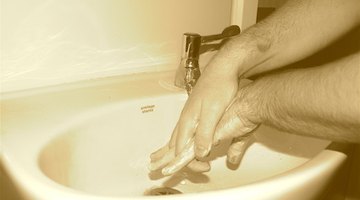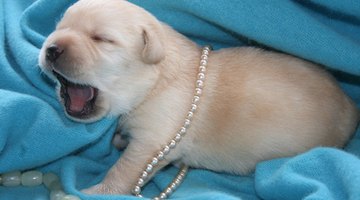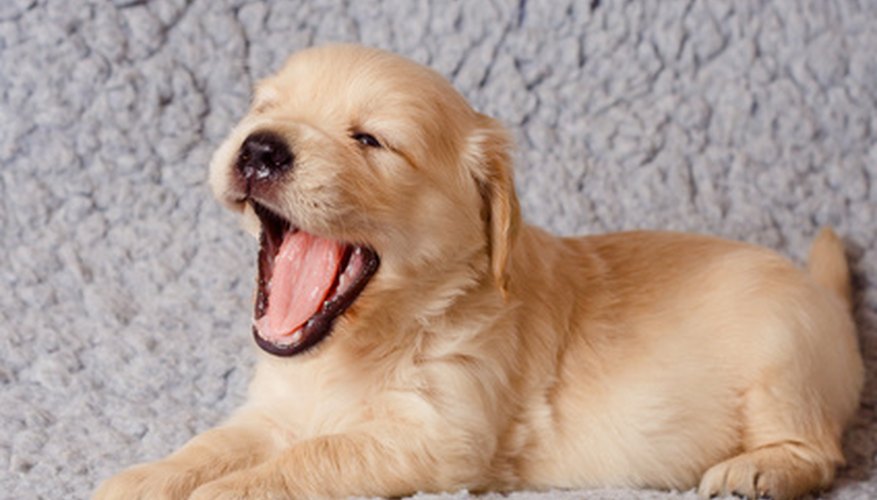There are few things more adorable than newborn Golden Retriever puppies.
Golden Retrievers are usually excellent mothers, have easy births and take great care of their puppies.
They are also usually comfortable when their owners handle and care for the puppies.
So this can be a very enjoyable time; however, there is a lot of work involved and a multitude of things that can go wrong. Preparation is key.

Wash your hands thoroughly every time before handling the puppies or their mother.
- There are few things more adorable than newborn Golden Retriever puppies.
- Wash your hands thoroughly every time before handling the puppies or their mother.
Remove your street shoes before entering the puppy room. Shoes are a common source of germs or parasites that can infect the puppies. If you have been around other animals or sick people, change your clothing before entering the puppy room.
Remove the sac from each puppy as it is born, allowing the mother to sniff, clean and chew the umbilical cord. The puppy can't breathe until the sac is removed. Pull it away quickly and then suction out the nose and mouth with the syringe.
- Remove the sac from each puppy as it is born, allowing the mother to sniff, clean and chew the umbilical cord.
Swab the stump of the umbilical cord with the iodine.
Allow Mom to investigate and clean her pup, and then weigh the puppy and record its birth time, weight, sex and colour of its collar. Put a coloured puppy collar on the pup loosely. Ensure the collar is not too tight or loose enough for another pup to become entangled in it. Keep in mind that the puppies grow at a very fast rate so be sure to check the collars daily.

Allow each puppy to nurse after weighing it. If the mother is already delivering again, put the puppy in the plastic box under the heat lamp. It's OK to keep the puppies in the plastic box through most of the birthing; however, each puppy should be allowed to nurse within the first few minutes of birth, to receive colostrum. It is very important that the puppy receive the colostrum.
- Allow each puppy to nurse after weighing it.
- It's OK to keep the puppies in the plastic box through most of the birthing; however, each puppy should be allowed to nurse within the first few minutes of birth, to receive colostrum.
The heat lamp should not be too close to the puppy. Once all of the puppies are born, place the puppies with the mother to nurse. Move the heat lamp towards the whelping box, but aim it so that the puppies can crawl back and forth as they get too warm or too cold. A puppy cannot regulate its own body temperature for the first few weeks.
Make a bed for the family, if the mother gave birth in some place other than a whelping box. For a Golden Retriever mother and puppies, a box that is 4 feet by 4 feet with sides about 12 inches high is good. A plastic moulded kiddie pool will work fine too.
Weigh each puppy twice daily for the first week and record the weights and times.
Swab iodine on the umbilical stump twice a day until it dries up. Infections can lead quickly to septicaemia in such small bodies.
If a puppy loses weight after the first 24 hours it should be watched carefully for problems and supplemented with a bottle feeding. If it continues to lose weight, take it to the veterinarian, along with the recorded weights since birth.
- Make a bed for the family, if the mother gave birth in some place other than a whelping box.
- If a puppy loses weight after the first 24 hours it should be watched carefully for problems and supplemented with a bottle feeding.
Weigh daily after the first week, until about 4 weeks of age.
Assist the puppies as needed when they nurse. Some will have more trouble than others, so help the weaker nursers and be sure all puppies get enough milk. Smaller or weaker puppies may need some private time with mom or a bottle of puppy formula, one or more times a day.
- Weigh daily after the first week, until about 4 weeks of age.
- Some will have more trouble than others, so help the weaker nursers and be sure all puppies get enough milk.
Notice any signs of trouble, such as lethargy, coldness, failing to nurse. If any puppy seems at all "off" to you call the veterinarian. Small things turn fatal very fast with newborn puppies.

Handle each puppy daily, holding it securely but changing it to different positions, such as turning it on its back, and then back to its tummy. This is mildly stressful and helps the pups develop well while also preparing them for being pets when they are older. Do not allow small children or strangers to handle the puppies.
- Handle each puppy daily, holding it securely but changing it to different positions, such as turning it on its back, and then back to its tummy.
- This is mildly stressful and helps the pups develop well while also preparing them for being pets when they are older.
Change the newspapers and other bedding in the box every day or as needed. As the pups get bigger the papers and towels will need to be changed a few times each day.
Introduce the puppies to semi-solid foods at around four weeks of age. This should be a gruel made of dry puppy food soaked in puppy formula until it is mushy. It's normal for them to make a huge mess with their food; they are learning. Clean them up with a warm, damp wash cloth.
Deworm and vaccinate the puppies according to your veterinarian's instructions. Do not give them over the counter worm medicine, as these may not all be safe. Deworming starts around three weeks of age and vaccinations at about 6 weeks, but consult with your veterinarian as there are times when changes to the schedule are needed.
TIP
Mom's health is crucial to the welfare of the puppies, so make sure you feed her a good quality dog food. She needs much more food while nursing puppies. If several hours go by and there are no more puppies, take the mom to the veterinarian for an exam and X-ray to be sure there are no more puppies.
WARNING
If the mom is straining or having contractions without producing a puppy, call the veterinarian immediately. If the puppy does not start breathing after clearing the mucous and sac away and using suction, you can try to revive it with brisk but gentle towel massage. Also, wrap the pup in a towel, face down, and with the towel and both of your hands fully supporting the head, neck, and body, briskly swing your raised arms downward to help dislodge any mucous.The puppy must be fully supported or this will break its neck.
